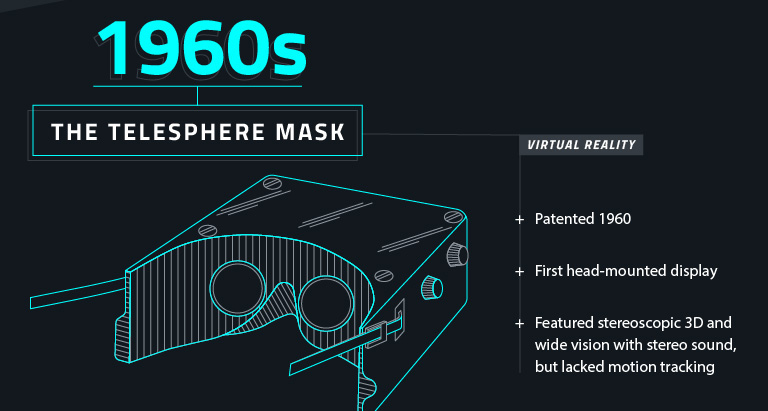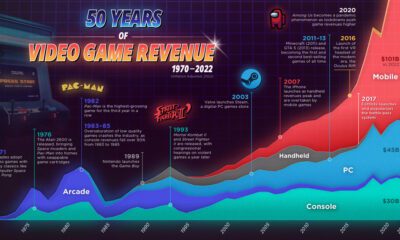Technology
The Evolution of Virtual Reality
For much of modern history, people have longed to find ways to temporarily escape the mundane and sometimes harsh realities of everyday life.
Following the invention of the Gutenberg press, readers could use their imaginations to “get lost” in fiction books to take a break from all things ordinary. More recently, it has been inventions such as television, movies, and video games that have gotten us even closer to achieving true escapism.
And while that progress is impressive, it is likely that today’s virtual reality technology may be the biggest leap forward yet. The virtual reality experiences coming out right now are so real and immersive, that the “realness” has actually become a potential psychological pitfall for developers to overcome.
As the technology continues to grow, virtual reality will allow us the ultimate escape. We will be able to completely immerse in new experiences such as journeying to new planets, solving mysteries, or flying alongside our favorite superheroes to prevent the next global catastrophe.
The Evolution of Virtual Reality
Although it was the most recent developments in technology that have tipped virtual reality towards mainstream use, the concept of virtual reality itself has been a long time coming.
Today’s infographic from Communications@Syracuse shows the evolution of virtual reality, and how new ideas and products over time have helped to put the technology on its current course.

Interestingly, the seeds for the evolution of virtual reality were actually sown as early as the 1930s and 1940s.
The first important precursor was the Link Trainer, which was used as a flight simulator for the U.S. military. This device, which would be ultimately used to train over 500,000 U.S. pilots, was entirely electromechanical in nature. By using a series of pumps, valves, and bellows to respond to the pilot’s controls, it produced an accurate reading on flight instruments.
Around the same time the Link Trainer became widespread in use, Sawyer’s View-Master was introduced at the New York World’s Fair in 1939-1940. Today it is still a popular children’s toy, having sold over 100 million viewers worldwide since then. The View-Master uses reels of stereoscopic film to provide the illusion of 3d images through the plastic binocular set.
Technology
All of the Grants Given by the U.S. CHIPS Act
Intel, TSMC, and more have received billions in subsidies from the U.S. CHIPS Act in 2024.

All of the Grants Given by the U.S. CHIPS Act
This was originally posted on our Voronoi app. Download the app for free on iOS or Android and discover incredible data-driven charts from a variety of trusted sources.
This visualization shows which companies are receiving grants from the U.S. CHIPS Act, as of April 25, 2024. The CHIPS Act is a federal statute signed into law by President Joe Biden that authorizes $280 billion in new funding to boost domestic research and manufacturing of semiconductors.
The grant amounts visualized in this graphic are intended to accelerate the production of semiconductor fabrication plants (fabs) across the United States.
Data and Company Highlights
The figures we used to create this graphic were collected from a variety of public news sources. The Semiconductor Industry Association (SIA) also maintains a tracker for CHIPS Act recipients, though at the time of writing it does not have the latest details for Micron.
| Company | Federal Grant Amount | Anticipated Investment From Company |
|---|---|---|
| 🇺🇸 Intel | $8,500,000,000 | $100,000,000,000 |
| 🇹🇼 TSMC | $6,600,000,000 | $65,000,000,000 |
| 🇰🇷 Samsung | $6,400,000,000 | $45,000,000,000 |
| 🇺🇸 Micron | $6,100,000,000 | $50,000,000,000 |
| 🇺🇸 GlobalFoundries | $1,500,000,000 | $12,000,000,000 |
| 🇺🇸 Microchip | $162,000,000 | N/A |
| 🇬🇧 BAE Systems | $35,000,000 | N/A |
BAE Systems was not included in the graphic due to size limitations
Intel’s Massive Plans
Intel is receiving the largest share of the pie, with $8.5 billion in grants (plus an additional $11 billion in government loans). This grant accounts for 22% of the CHIPS Act’s total subsidies for chip production.
From Intel’s side, the company is expected to invest $100 billion to construct new fabs in Arizona and Ohio, while modernizing and/or expanding existing fabs in Oregon and New Mexico. Intel could also claim another $25 billion in credits through the U.S. Treasury Department’s Investment Tax Credit.
TSMC Expands its U.S. Presence
TSMC, the world’s largest semiconductor foundry company, is receiving a hefty $6.6 billion to construct a new chip plant with three fabs in Arizona. The Taiwanese chipmaker is expected to invest $65 billion into the project.
The plant’s first fab will be up and running in the first half of 2025, leveraging 4 nm (nanometer) technology. According to TrendForce, the other fabs will produce chips on more advanced 3 nm and 2 nm processes.
The Latest Grant Goes to Micron
Micron, the only U.S.-based manufacturer of memory chips, is set to receive $6.1 billion in grants to support its plans of investing $50 billion through 2030. This investment will be used to construct new fabs in Idaho and New York.
-

 Energy1 week ago
Energy1 week agoThe World’s Biggest Nuclear Energy Producers
-

 Money2 weeks ago
Money2 weeks agoWhich States Have the Highest Minimum Wage in America?
-

 Technology2 weeks ago
Technology2 weeks agoRanked: Semiconductor Companies by Industry Revenue Share
-

 Markets2 weeks ago
Markets2 weeks agoRanked: The World’s Top Flight Routes, by Revenue
-

 Countries2 weeks ago
Countries2 weeks agoPopulation Projections: The World’s 6 Largest Countries in 2075
-

 Markets2 weeks ago
Markets2 weeks agoThe Top 10 States by Real GDP Growth in 2023
-

 Demographics2 weeks ago
Demographics2 weeks agoThe Smallest Gender Wage Gaps in OECD Countries
-

 United States2 weeks ago
United States2 weeks agoWhere U.S. Inflation Hit the Hardest in March 2024














